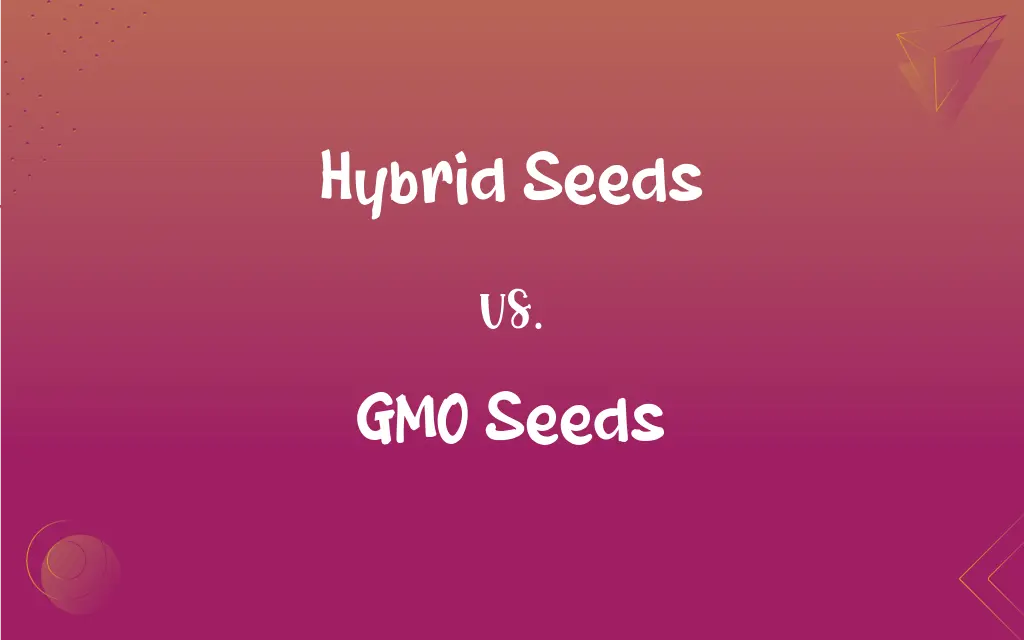Hybrid Seeds vs. GMO Seeds: What's the Difference?
Edited by Aimie Carlson || By Harlon Moss || Updated on October 26, 2023
Hybrid seeds come from cross-pollinated plants, while GMO seeds are genetically modified for specific traits.

Key Differences
Hybrid seeds result from cross-pollinating two different, but related, plant varieties. GMO seeds are created by altering the plant's DNA in a laboratory to exhibit specific traits.
The creation of hybrid seeds is a natural process of breeding plants. In contrast, producing GMO seeds involves scientific intervention at the genetic level.
Hybrid seeds often yield plants with enhanced characteristics like disease resistance. GMO seeds, however, can have more precise traits like pesticide resistance or nutritional enhancement.
The offspring of hybrid seeds may not retain the desired qualities. GMO seeds, once altered, pass the modifications to their offspring consistently.
Hybridization has been practiced for centuries in agriculture. Genetic modification of seeds, however, is a more recent development, involving advanced biotechnology.
ADVERTISEMENT
Comparison Chart
Method of Creation
Natural cross-pollination
Laboratory genetic modification
Trait Consistency
Less consistent in offspring
Traits consistently passed to offspring
Purpose
Improve characteristics like yield, taste
Introduce specific traits like drought resistance
Historical Use
Centuries-old practice
Recent development, few decades old
Offspring Viability
Offspring may not retain desired traits
Offspring retain modified traits
ADVERTISEMENT
Hybrid Seeds and GMO Seeds Definitions
Hybrid Seeds
Result of cross-pollinating different plant varieties.
The hybrid seeds produced a more robust crop.
GMO Seeds
Consistently pass modified traits to offspring.
The traits in GMO seeds are heritable.
Hybrid Seeds
Aim to combine desirable traits of parent plants.
These hybrid seeds combine flavor and hardiness.
GMO Seeds
Genetically modified for specific traits.
GMO seeds were developed for pest resistance.
Hybrid Seeds
Not genetically modified but naturally bred.
Hybrid seeds are a product of traditional breeding.
GMO Seeds
Altered at the DNA level in laboratories.
These GMO seeds have enhanced nutritional content.
Hybrid Seeds
Can lead to increased yield and disease resistance.
Farmers prefer hybrid seeds for better yield.
GMO Seeds
Subject to regulations and ethical debates.
The use of GMO seeds is often controversial.
Hybrid Seeds
Offspring may not retain parental characteristics.
The next generation from hybrid seeds may vary.
GMO Seeds
Can exhibit traits like drought resistance.
GMO seeds are used in arid regions.
FAQs
Are hybrid seeds reusable?
They can be, but offspring traits may vary.
Are GMO seeds labeled in stores?
In many places, labeling is required.
Can I grow organic crops with hybrid seeds?
Yes, if other organic practices are followed.
What are GMO seeds?
Seeds genetically modified for specific traits.
Can hybrid seeds be organic?
Yes, if grown without synthetic inputs.
Is genetic modification safe?
Generally considered safe, but subject to regulation.
Do hybrid seeds improve crop yield?
Often, by combining desirable traits.
Can GMO seeds reduce pesticide use?
Some are designed to reduce pesticide reliance.
Can I save seeds from hybrid plants?
Yes, but next generation traits may differ.
Are hybrid seeds natural?
Yes, they're produced through natural cross-pollination.
Are GMO seeds better than traditional seeds?
It depends on the specific needs and context.
Do GMO seeds harm the environment?
Opinions vary; some raise concerns about biodiversity.
Do hybrid seeds need special care?
They may have specific cultivation needs.
Do GMO seeds always need pesticides?
Some are modified for pesticide resistance, reducing need.
Why choose hybrid seeds?
For improved yield, taste, or disease resistance.
Are hybrid seeds genetically modified?
No, they're a result of selective breeding.
How are GMO seeds made?
Through precise genetic engineering techniques.
Can hybrid seeds help with climate change?
Potentially, by offering drought-resistant varieties.
Do GMO crops have different nutritional content?
Some are engineered for enhanced nutrition.
Why is there controversy around GMO seeds?
Concerns include environmental impact and ethics.
About Author
Written by
Harlon MossHarlon is a seasoned quality moderator and accomplished content writer for Difference Wiki. An alumnus of the prestigious University of California, he earned his degree in Computer Science. Leveraging his academic background, Harlon brings a meticulous and informed perspective to his work, ensuring content accuracy and excellence.
Edited by
Aimie CarlsonAimie Carlson, holding a master's degree in English literature, is a fervent English language enthusiast. She lends her writing talents to Difference Wiki, a prominent website that specializes in comparisons, offering readers insightful analyses that both captivate and inform.































































